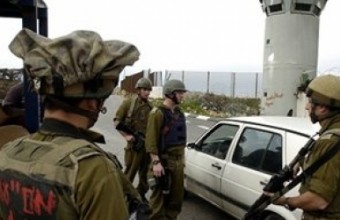Israeli forces Wednesday blocked off the main entrance leading to Beit Ummar town, north of Hebron, and shut down the Jerusalem-Hebron main Road, hampering Palestinians’ movement, according to a local activist.Spokesperson of the anti settlement popular committee in Beit Ummar, Mohammed Awad, informed WAFA Palestinian News Agency that Israeli forces placed a military checkpoint at the town’s main entrance, inspecting residents’ identity cards and obstructing their movement.
The Israeli soldiers also set up a checkpoint at the Jerusalem-Hebron main Road, where they inspected the identity cards of passing Palestinian-registered vehicles, causing a traffic jam. They further detained a number of Palestinian youths at the side of the road after retaining their ID cards, however, no arrests were made.
B’Tselem, the Israeli Information Center for Human Rights in the occupied Palestinian Territories, said that in February 2014 there were 99 fixed checkpoints in the West Bank: 59 are internal checkpoints, located well within the occupied West Bank.
The presence of such checkpoints within the West Bank has always raised questions regarding their so-called security purposes. Palestinians believe that such checkpoints are only set up to restrict Palestinians’ movement and control their lives.
It said that, “The restrictions still in place in the West Bank impede Palestinian access to areas where Israel is interested in retaining control, such as East Jerusalem, the Jordan Valley, enclaves west of the Separation Barrier and settlements in the heart of Hebron.”
“These restrictions prevent Palestinians from using some of the main roads and highways in the West Bank – including parts of Route 60 and Route 443. Settlers travel freely along these roads, while Palestinians are shunted to longer routes using side roads.”
Al-Haq Center for Human Rights stressed that, “Hundreds of Israeli military checkpoints and barriers restricted the movement of Palestinians in the West Bank, hindering or blocking access to workplaces, education and health facilities, and other services.”


